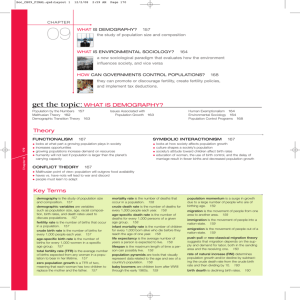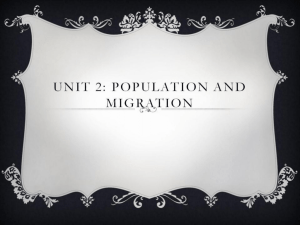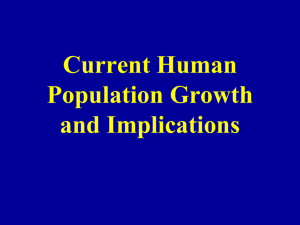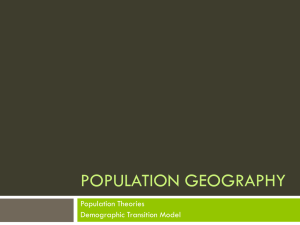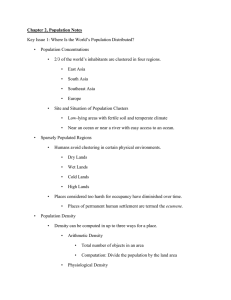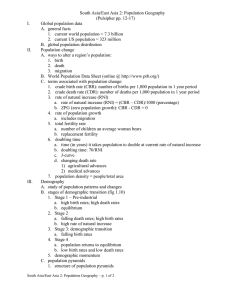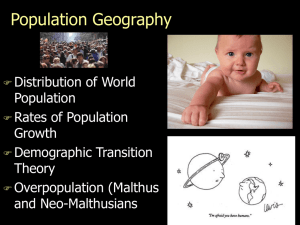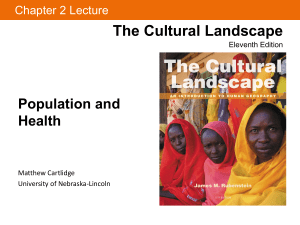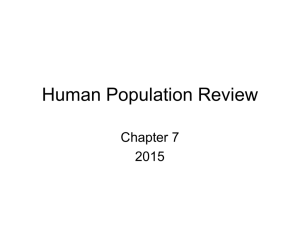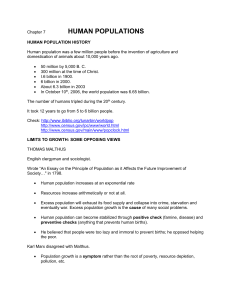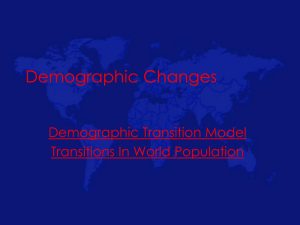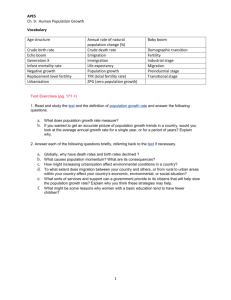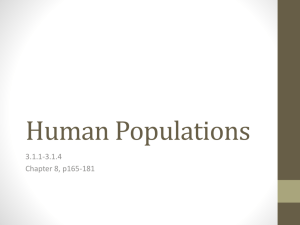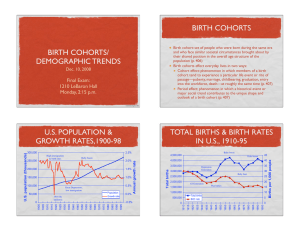USING DATA TO TRACK POPULATION TRENDS
advertisement
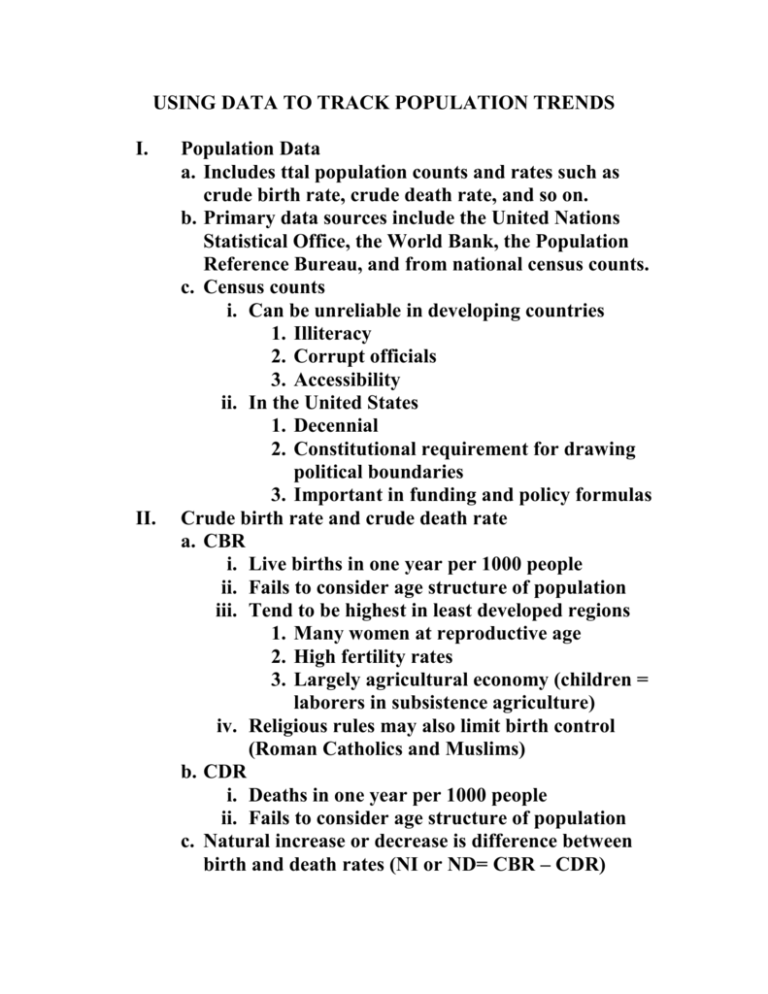
USING DATA TO TRACK POPULATION TRENDS I. II. Population Data a. Includes ttal population counts and rates such as crude birth rate, crude death rate, and so on. b. Primary data sources include the United Nations Statistical Office, the World Bank, the Population Reference Bureau, and from national census counts. c. Census counts i. Can be unreliable in developing countries 1. Illiteracy 2. Corrupt officials 3. Accessibility ii. In the United States 1. Decennial 2. Constitutional requirement for drawing political boundaries 3. Important in funding and policy formulas Crude birth rate and crude death rate a. CBR i. Live births in one year per 1000 people ii. Fails to consider age structure of population iii. Tend to be highest in least developed regions 1. Many women at reproductive age 2. High fertility rates 3. Largely agricultural economy (children = laborers in subsistence agriculture) iv. Religious rules may also limit birth control (Roman Catholics and Muslims) b. CDR i. Deaths in one year per 1000 people ii. Fails to consider age structure of population c. Natural increase or decrease is difference between birth and death rates (NI or ND= CBR – CDR) i. CBR of 22 per 1000 – CDR of 12 per 1000 = Natural increase of 10 per 1000 or 1% ii. Above 2 % is considered high iii. Determining factors 1. Economic development = access to health care, employment and nutrition 2. Better education = lower rates of disease 3. Gender empowerment: women with more economic and political access and education will lower fertility rates. 4. Social and religious norms regarding contraception 5. Public policies a. Pronatalist – addresses the issue of declining population by encouraging births through subsidized child care costs and and generous maternity leave benefits b. Antinatalist – addresses the issue of overpopulation by discouraging births with contraception, child limits and even sterilization III. Infant mortality a. Deaths during first year of life per 1000 live births b. Usually higher in developing regions due to a lack of access to health care services c. Rates have decreased significantly over last 50 years IV. Life expectancy a. Average number of years an infant newborn can expect to live b. Developed countries have much higher lie expectancies than developing countries c. Varies widely from group to group: urban, rural, ethnicity, sex, employment, habits, associations V. Total fertility rate a. Average number of children a woman will have during her childbearing years (age 15 – 49) b. Allows demographers to predict birth rates of a particular group over time. c. Replacement level fertility = slightly more than 2 but may be higher due to infant mortality. VI. Demographic accounting equation: predicts population change within a particular area as a function of natural change and migration VII. Global population growth and doubling time a. The amount of time it will take a particular population to double in size b. Populations with 1% growth rate double in 70 years c. Populations with 2% growth rate double in 35 years d. Exponential growth, which truly began in the 1950’s are graphed as a J-curve. e. Recent decades have shown a reduced growth rate creating more of an S-curve. VIII. Population pyramids a.k.a. age-sex pyramids a. Types i. Rapid growth - with a wide base ii. Stability - with a rectangular shape iii. Decline – with a smaller base than the top iv. Disrupted – with gaps due to drastic events (war, disaster, policy, etc.) b. U.S. Trends i. Baby Boom 1. Individuals born post WWII (1946 – 1964) 2. Largest population cohort in U.S. demographic history 3. Retirement of this generation will create economic burdens for younger, productive generations. ii. Baby bust 1. Fertility rates dropped in the 1960s and 70s creating lower CBR 2. Baby boom women sought higher levels of education, and more competitive careers 3. Many women had fewer children later in life IX. Dependency ratio a. A measure of the economic impact of younger and older cohorts on economically productive members of a population b. Younger cohorts are typically children under age 15 c. Older cohorts are typically retirees age 64+ X. Sustainability a. Using resources in a manner that supplies existing populations while not compromising availability of resources for future generations b. Limiting population growth relieves pressure on future generations’ resource needs c. In the 1994 U.N. Meeting on Population and Development in Cairo, developing countries with higher population growth rates criticized developing regions for their over-consumption and argued that they needed to focus on resource conservation. XI. Demographic transition model: describes population growth stabilization as a function of economic development a. Phases i. Pre-industrialization: high birth and death rates ii. Transition to industrialization: high birth and low death rates iii. Mostly industrialized: birth rates drop iv. Highly developed: population growth is stable or negative b. Downfalls of the demographic transition model i. Designed to describe the demographic history of Europe ii. Export of medical technology and public health policies to developing regions since the 1950’s slowed death rates without decreasing birth rates iii. Developing world’s population is exploding as it is industrializing XII. Impact of HIV/AIDS a. Creates a major and dramatic exception to recent population growth trends particularly in the developing world b. Fourth most common cause of death world wide, will likely become the worst epidemic in history c. AIDS and Sub-Saharan Africa i. Expected loss of life from the disease = 68 million (55 million between 2000 and 2020) ii. In 2006, 65% of the 40,000,000 people across the globe diagnosed with HIV lived in SubSaharan Africa iii. In some countries 1 in 4 people carry the virus iv. In Botswana, life expectancy has been cut in half from 70 to 35.

